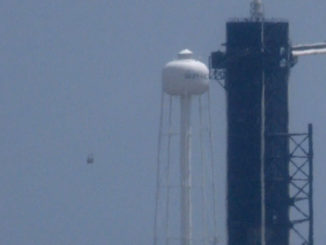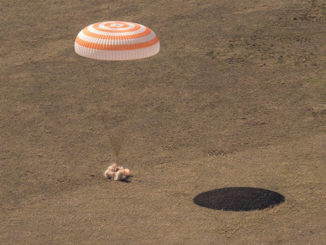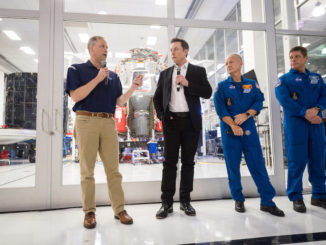
Chinese officials confirmed the successful launch of the first element of the country’s space station early Thursday, laying the keystone to a permanently-inhabited orbiting habitat that could welcome its first astronauts this summer.
The liftoff of the Tianhe core module begins the most ambitious project in the history of China’s nearly 30-year human spaceflight program, which seeks to create a national space station after being shut out of the International Space Station, led by U.S. and Russian space agencies.
China’s Tianhe space station core module rode a heavy-lift Long March 5B rocket into orbit after liftoff at 11:23:15 p.m. EDT Wednesday (0323:15 GMT; 11:23:15 a.m. Beijing time Thursday).
Ten liquid-fueled engines ignited to send the 176-foot-tall (53.7-meter) Long March 5B rocket off the launch pad at the Wenchang spaceport on Hainan Island, China’s southernmost province.
The eight kerosene-burning booster engines and twin hydrogen-fed core engines generated 2.4 million pounds of thrust at full power. The stubby, heavy-duty rocket climbed through a cloud deck over Wenchang and turned to the southeast over the South China Sea.
Chinese state-run television broadcast the launch live, showing spectacular views from on-board “rocket cams” that captured video of the Long March 5B soaring through clouds and shedding spent components on the way into orbit.
The four strap-on boosters — each powered by two engines — shut down and jettisoned nearly three minutes into the mission. Moments later, the nose cone enshrouding the Tianhe spacecraft peeled away as the rocket reached the rarefied environment of space.
The Long March 5B is a variant of China’s heavy-lift Long March 5 rocket specially designed to haul heavy elements of China’s space station into orbit. The Long March 5B flies without the Long March 5’s second stage, making room for a large spacecraft to fit inside the rocket’s payload shroud.
The Long March 5B’s main stage released the Tianhe module about eight minutes after liftoff. Around one hour into the flight, ground teams in China announced the Tianhe spacecraft extended two power-producing solar array wings.
In a speech, a Chinese military official proclaimed the launch a “complete success” and said the Tianhe spacecraft was functioning normally after riding to space on the Long March 5B.

The massive core module is the largest and heaviest spacecraft ever built in China, extending more than 54.4 feet (16.6 meters) long, with a maximum diameter of around 13.8 feet (4.2 meters). Fully fueled at launch, the Tianhe module weighed roughly 49,600 pounds (22.5 metric tons), according to China’s state-run Xinhua news agency.
The core module resembles the first section of Russia’s Mir space station, but the Tianhe spacecraft is longer and heavier.
Three Chinese astronauts could visit the Tianhe core module as early as June to begin a three-month stint in orbit, with future crew missions building up to stays as long as six months, officials said. But first, a cargo freighter will link up with the space station’s core module in orbit next month, delivering supplies and provisions to support the first astronauts to live on the outpost.
The launch of the Tianhe core module was the first of 11 missions before the end of 2022 to install additional elements on the space station, and ferry cargo and astronauts to the orbiting research laboratory. The remaining 10 missions to continue construction and outfitting of the space station include the launch of two more research modules, plus four Tianzhou cargo ships and four Shenzhou crew spacecraft.
The joining of the Tianhe module with the station’s two similarly-sized research labs will give the complex the shape of a T.
The Tianhe, or “Heavenly Harmony,” core module is the keystone of the China’s Tiangong, or “Heavenly Palace,” space station in low Earth orbit a few hundred miles above the planet, serving as astronaut living quarters, a command and control element, an airlock for spacewalks, and a docking port for attachment of future crew and cargo vehicles.
The module has medical equipment, a galley and dining area, sleep stations, and other accommodations for astronauts, according to the China Aerospace Science and Technology Corp., the government-owned prime contractor for China’s space program. The Tianhe core module also has handrails to assist astronauts moving around outside the space station on spacewalks.
Chinese officials confirmed the successful launch of the first element of the country’s space station early Thursday, laying the keystone to a permanently-inhabited orbiting habitat that could welcome its first astronauts this summer.
Full story: https://t.co/qXTjVABGap pic.twitter.com/YWemXsptE7
— Spaceflight Now (@SpaceflightNow) April 29, 2021
“We will learn how to assemble, operate and maintain large spacecraft in orbit, and we aim to build Tiangong into a state-level space lab supporting the long stay of astronauts and large-scale scientific, technological and application experiments,” said Bai Linhou, deputy chief designer of the space station at the China Academy of Space Technology, a state-run spacecraft manufacturer.
Chinese officials signaled they are open to international participation in the space station program.
“The station is also expected to contribute to the peaceful development and utilization of space resources through international cooperation, as well as to enrich technologies and experience for China’s future explorations into deeper space,” Bai said, according to a report published by the Xinhua news agency.
The fully-assembled outpost will be around 66 metric tons, about one-sixth the mass of the International Space Station, and closer in size to Russia’s retired Mir station than the ISS. With cargo and crew vehicles temporarily docked, the Chinese station’s mass could reach nearly 100 metric tons, officials said.
China launched two Tiangong prototype space labs in 2011 and 2016 to test out technologies for the permanently-occupied space station.
The Tiangong 1 space lab hosted two Shenzhou crew in 2012 and 2013, and China’s most recent human spaceflight mission — Shenzhou 11 — docked with the Tiangong 2 module in 2016. In total, China has launched six astronaut missions on Shenzhou capsules since 2003.
China also launched a test flight of the Tianzhou supply ship, similar in function to Russia’s Progress or SpaceX’s Cargo Dragon capsule supporting the International Space Station. The first Tianzhou freighter took off on a Long March 7 rocket in 2017 and docked with the Tiangong 2 space lab, proving out automated docking and in-orbit refueling technology.
After the Tiangong pathfinders verified key technologies for the Chinese space station, officials are moving ahead with integrating the complex in low Earth orbit between 210 miles (340 kilometers) and 280 miles (450 kilometers) above Earth.

With the Tianhe module now orbit, Chinese space officials will complete preparations for launch of a Long March 7 rocket in May carrying the Tianzhou 2 resupply ship. The cargo freighter will automatically dock with the Tianhe module a few days after launch, setting the stage for liftoff of a Long March 2F from the Jiuquan space base as soon as June with the first astronaut crew to visit the nascent space station.
Chinese officials have said they have selected crew members for the Shenzhou 12 mission, and astronaut training is underway. The astronauts will carry out multiple spacewalks on their mission to link up with the Tianhe module in orbit.
Another Tianzhou cargo craft and the Shenzhou 13 crew mission will launch later this year, delivering supplies and astronauts for the first full-term six-month stay on the Tiangong space station.
The Tianhe core module has life support hardware to recycle urine, exhaled breath condensate, and carbon dioxide, Chinese officials said. That will limit how much water and oxygen needs to be packed into Tianzhou cargo ships.
Chinese officials say the space station is designed to operate for more than 10 years, and perhaps longer than 15 years with “appropriate maintenance and repairs,” Xinhua said. Once assembly is complete, the station will be able to permanently host three astronauts, with short-term stays of six astronauts possible during crew changeovers.

The core module has an internal living volume of about 1,765 cubic feet (50 cubic meters), according to Xinhua. With all three modules, the living space will grow to 3,884 cubic feet (110 cubic meters). For comparison, NASA says the International Space Station has a habitable volume of 13,696 cubic feet (388 cubic meters).
One of the two research modules scheduled for launch next year, named Wentian, will have a larger airlock than the Tianhe core module to support spacewalks, plus a robotic arm to move payloads and science experiments outside the space station.
The other research module, named Mengtian, is similar to Wentian but has a special airlock to transfer cargo and instruments between the interior and exterior of the space station, Xinhua said.
In addition to the two new modules China is readying for launches in 2022, the Tiangong space station is also due to receive two more Tianzhou cargo spacecraft and two more Shenzhou crew ships next year.
Email the author.
Follow Stephen Clark on Twitter: @StephenClark1.



